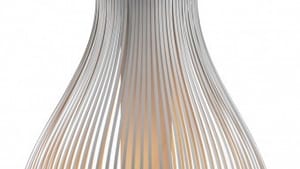Stay in the Loop
BSR publishes on a weekly schedule, with an email newsletter every Wednesday and Thursday morning. There’s no paywall, and subscribing is always free.
Soulful contemporary
Philadelphia Museum of Art's 'Patricia Urquiola: Between Craft and Industry'

Patricia Urquiola: Between Craft and Industry at the Philadelphia Museum of Art (PMA) presents the first solo exhibition celebrating the tactile, stylish work of this Spanish-born designer, who lives in Milan. Though trained as an architect, her Studio Urquiola consults internationally on product design and, recently, interiors. These include luxury hotels such as Barcelona’s Mandarin Oriental (2010) and Il Sereno (2016) on Italy’s Lake Como.
Contemporary style is a visual palate cleanser, a break from filigreed fussiness trumpeting a designer’s skill. Design serves purpose, with clean edges and spare surfaces. In contemporary design, less is more. But in the wrong hands, less can be too much: Clean edges become knives; spare surfaces, barriers. Taken too far, contemporary design can be cold, robotic, soulless.
Straightforward and inviting
In the right hands, contemporary buildings, interiors, and objects eliminate visual clutter but always appear designed by and for humans. The work of Patricia Urquiola exemplifies this approach, achieving a streamlined yet artisanal style.
Her large-scale projects are displayed in photographs, but Urquiola’s furnishings best convey the visceral sense of her work. Tea sets, chairs, chaises, tiles, rugs, and lamps line PMA’s Alter Gallery on ankle-high platforms that bear reminders not to step up. It’s a standard request, but especially necessary because the items entice one to lean in, sit down, and touch.
Take a seat
Seating is a large part of the exhibition, as Urquiola designs for manufacturers of office and commercial furniture. The “Crinoline Chair” (2008) featured in exhibition materials is indeed named for stiff petticoats and made from abaca, a straw-colored fiber related to the banana plant.
It’s a familiar silhouette that would suit Tara’s front porch. The back fans up and out, but instead of a monotonous woven field, the top of the chair has been been invaded by a mass of flowers. The design grew from Urquiola’s collaboration with Asian crafters producing the chair.

The “Husk Chair” (2011) is what the designer calls a gender chair, which is to say it can be soft, hard, light, dark or any combination of those qualities. Looking like an eggshell lined with a thick cushion that resembles pillowy bubble wrap, it practically screams, “Dive in and curl up!”
It’s easy to picture the “Pouf Chair” (2014) in public areas. Small and gumdrop-shaped, it has a curved back that swivels up or down as needed. It’s like a functional version of Miss Muffet’s tuffet. Poufs could easily cluster in reception areas and lobbies, or around tables and desks.
Design for utility and feeling
From her studio in Milan, Urquiola frequently collaborates with large manufacturers. For Haworth, a workspace design firm in Holland, Michigan, she created the Openest collection, which includes the Pouf and “Single Desk” (2015), a refined take on the cubicle.
Though the curved upholstered shell harboring a desktop is more stylish than its modular office ancestors, it’s still a cubicle. And for anyone who has worked in one, even good design is unlikely to improve the experience.
Urquiola says she designs not only for utility, but to spark recognition and emotion. Cubicle flashbacks aside, her objects and spaces are inviting. Simple but not sterile, soothing but not static, stimulating but not jangly, they make users want to engage.
Paraphrasing late Italian designer Achille Castiglioni, Urquiola compares her approach to putting marmalade on bread: the idea is the topping, but constraint is the foundation.

Tech: an artisanal ally
On the designer's website, she says she views emerging fabrication methods as opportunities: “I’m interested in the new poetics that come from new technology: 3D printing, digital, new machines. They give you new approaches to create series. Why not introduce that in the way we approach our conversations and our work with industry?”
The influence of handicraft and industrial production can be seen in the “Chasen Lamp” (2007). It was inspired by Japanese tea whisks, which look like the short-bristled, knobbed brushes barbers use on collars. The pendant lamp’s luminous center is encased in a cage of flexible aluminum strips. The top and bottom of the cage can be pushed together or extended, endlessly adapting both the light and the lamp’s appearance.
Seeing a lamp in a tea whisk is only one of the surprising sources from which Urquiola draws inspiration. A white felt chaise longue overlaid with a blanket of three-dimensional pointed red petals surely must be based on the poinsettia? Well, no. It’s the “Antibodi Chaise” (2006), as in objects that might appear under a microscope.
The proof of Urquiola’s success happens in viewers’ responses to the designs: a repressed desire to sit down, to handle the dishware, to feel underfoot the interlocking white oak ladyfingers of the “Biscuit 3 Flooring” (2015), or to wrap up in the sweatery weave of the “Mangas” rug.
The day I viewed the show, a girl of about 12 stepped into the gallery and announced, “This is where I want to live.” She’s not the only one.
What, When, Where
Patricia Urquiola: Between Craft and Industry. Through March 4, 2018, at the Philadelphia Museum of Art, 2600 Benjamin Franklin Parkway, Philadelphia. (215) 763-8100 or philamuseum.org.
Sign up for our newsletter
All of the week's new articles, all in one place. Sign up for the free weekly BSR newsletters, and don't miss a conversation.
